
 |
|
|
|
|
#1 |
|
Vikingsword Staff
Join Date: Nov 2004
Posts: 6,262
|
I thought Barry's suggestion in the Swap forum a good idea !
So in that vein ; here's my one example that has been seen before by many of you . This is the only sword of its type that I have found and when I acquired it I was unsure of its origin . We used to have a link to an article on these in the resource section but I find that it has been taken down . So let's talk about these ; I hope our new Member will share his knowledge ( and pictures ) with us . 
|
|
|

|
|
|
#2 |
|
Vikingsword Staff
Join Date: Dec 2004
Location: The Aussie Bush
Posts: 4,034
|
The link to which Rick referred has been changed and the article can now be found here:
http://sevenstarstrading.com/article...n%20Aborigines There are also three old threads with much information about other types of Taiwanese swords, and they are here: http://www.vikingsword.com/ubb/Forum1/HTML/000582.html http://www.vikingsword.com/ubb/Forum1/HTML/000858.html http://www.vikingsword.com/ubb/Forum1/HTML/002486.html Ian. |
|
|

|
|
|
#3 |
|
Vikingsword Staff
Join Date: Nov 2004
Posts: 6,262
|
Thank you Ian .
|
|
|

|
|
|
#4 |
|
Member
Join Date: Sep 2005
Location: Ex-Taipei, Taiwan, now in Shanghai, China
Posts: 180
|
As I suggested in my second post on the swapforum, you will find a lot of informations on taiwanese tribes on Wikipedia. For more precise questions, no problem it's my pleasure to answer if I can. Rick, your sword is in fact from Taiwan. It is from the Rukai tribe and If I'm not mistaking should be a little over 50cm long. The Rukai and the Puyuma are two sub-groups of the Paiwan. They share a lot of common things with the Paiwan but still have their own particularities. They are living in the southern mountains of the island (if you have a good atlas, they are in the mountains 20 to 30 km away from the southern city of Pingtung) and are around 10 000 thousands today (the Paiwan proper are around 60 000 and the Puyuma, 10 000). These three tribes are mountain or hill tribes (by opposition with some other lowland or plain tribes of Taiwan). They were fierce headhunters, in a ritual purpose. They were among the last with the Bunun and the Atayal to fight against the Japanese before they were "pacified" in the twenties. But still some case of head huntings were reported at the end of the fourties. They were among the best soldiers when they fought in the rank of the Japanese army in the Pacific war (Taiwan was a japanese colony at that time and the aborigines considered themselves, after their pacification, as loyal subjects of the Emperor). They were very well known as military scouts, and if I don't mistake one of the last lost japanese soldiers to reappear from the jungle of South East Asia in the 70's was in fact a taiwanese aborigine. Concerning the swords or knives, the Paiwan (and the sub-groups which the Rukai are among) and the Yami that inhabits the Orchid Island (Lanyu in chinese, Botel Tobago former name), that are very well known for their pirogues, adorns their sheaths with motives. In the case of the Rukai, like on your sword, Rick, the serpent is fundamental as it is reprensenting the main ancestor of the tribe, a pattern that can be found on nearly every Paiwan objects.
|
|
|

|
|
|
#5 |
|
Vikingsword Staff
Join Date: Dec 2004
Location: The Aussie Bush
Posts: 4,034
|
Yuanzhumin:
Would you also care to identify the tribal origins of the following swords and knives? Example A: This one is from the collection of the distinguished host of this web site, Dr. Lee Jones, who posted the following pictures in 2001. OAL 28.75 inches (73 cm) 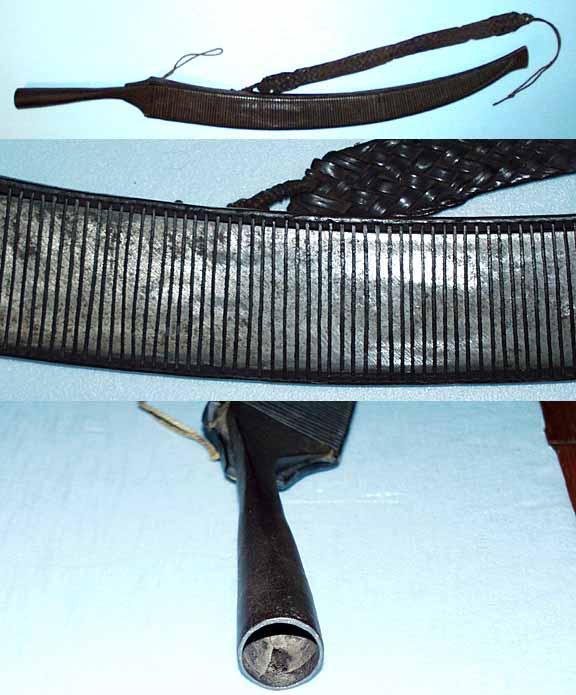 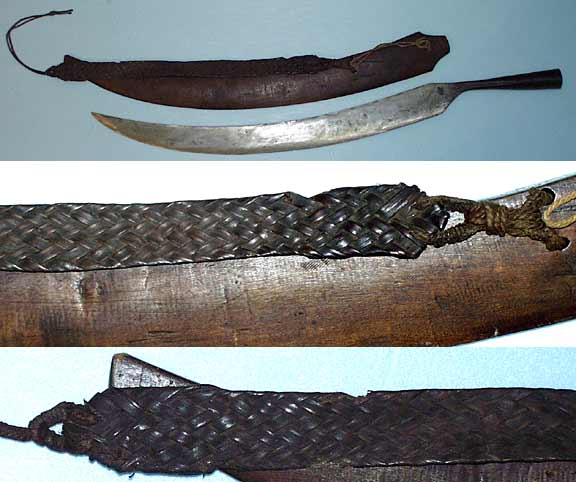 Examples B,C,D: These are from my own collection. B: OAL 19.75 inches. (50 cm) C: OAL 24 inches. (61 cm) D: OAL 34 inches (86 cm -- the largest of this style I have seen)  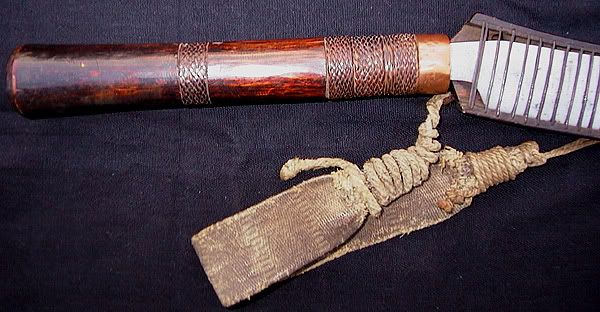 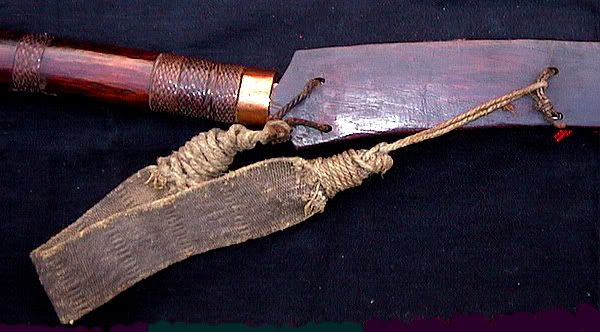 Example E: Another one of mine 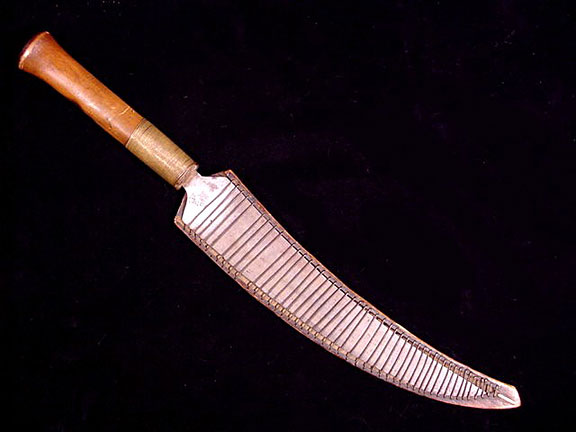 Thanks for any additional information you may have. Ian. Last edited by Ian; 17th September 2005 at 04:35 PM. Reason: Added dimensions in cm |
|
|

|
|
|
#6 |
|
Member
Join Date: Dec 2004
Location: What is still UK
Posts: 5,739
|
This is my one, sorry the picture is not very good. I am having peoblems with my camera wizard loading and editting program. This is the only one of these I have seen in the UK since I have been collecting. It was only through this site that I found out it was from Formosa. The total length of the blade and handle is 59 cm. Tim
Last edited by Tim Simmons; 17th September 2005 at 03:31 PM. Reason: adding more pictures |
|
|

|
|
|
#7 |
|
Member
Join Date: Dec 2004
Location: What is still UK
Posts: 5,739
|
Thank you yuanzhumin, for giving such enlightened information on the photographs. The book has many amazing pictures from around the world but was compiled at the beginning of the 20th century and is written in a very imperial manner, the text on some parts of the world borders on ridicule and any facts stated really have to be thought about. Tim
|
|
|

|
|
|
#8 |
|
Member
Join Date: Sep 2005
Location: Ex-Taipei, Taiwan, now in Shanghai, China
Posts: 180
|
Hereunder is an article taken from the 'Taiwan Review' about the knife maker, one of the last in Taiwan, to keep on doing knives following his family tradition. If you want pictures, I can send one or two.
Cultured Blade Publish Date: 06/01/2002 Story Type: ARTS; METALWORK Byline: JIM HWANG PHOTOS BY HUANG CHUNG-HSIN "There are numerous folding knives on the market, but this is the first and only one born and bred in Taiwan, and this is the only shop that sells them." The Kuo Ho Chi knife shop is situated on Tapei Street, close to the original location. It is just a few minutes' walk from the busiest section of the Shihlin Night Market. The Shihlin Night Market in northern Taipei is a popular spot for the young and not-so-young to gather after work. Thronged with visitors nearly every evening, the busy bazaar offers all kinds of snacks plus a wide assortment of clothing, furniture, and CDs. After their stomachs and shopping bags have both been stuffed, most visitors consider that there is no reason to linger. But those who are willing to explore a bit further may discover that the Shihlin district has another attraction. On Tapei Road, a narrow street just a few minutes' walk from the busiest section of the night market, lies the small Kuo Ho Chi cutlery shop founded by Kuo Ho in 1869. For more than 130 years in virtually the same location, the shop has been making a special folding pocketknife originally known as the Pachihlan knife--but called the Shihlin knife ever since Pachihlan was renamed Shihlin after the end of the Japanese colonial period in 1945. "There are numerous folding knives on the market, but this is the first and only one born and bred in Taiwan, and this is the only shop that sells them," says thirty-three-year-old Kuo Ming-jang, the great-great-grandson of the founder. Kuo Ho, who learned from a Cantonese craftsman the basics of making a piece of metal into a blade, was the creator of a unique pocketknife featuring an eggplant-shaped handle and bamboo-leaf-shaped blade. Why he was inspired to come up with this particular design is unknown, but the shape of the handle furnishes a superior grip and the blade is both attractive and highly effective for cutting, paring, and even shaving. Three major components--a buffalo-horn handle with brass liner, a brass lock-back (the piece of metal at the top of the handle that releases the blade from a locked position), and an iron-clad steel blade--are assembled with brass pins to form the folding knife. Although iron rusts, Kuo Ming-jang explains, the cladding protects the hard-but-brittle steel just as the wooden shaft in a pencil protects the lead inside, and it therefore increases the blade's durability. The Pachihlan folding knife won several knifemaking contests during the Japanese occupation. Although considered rather expensive, they were very popular due to their quality, durability, and convenience to carry. Up until the 1970s and early 1980s, they were still commonly used by all kinds of people from fishermen to betel-nut vendors. "It was in my father's tool bag--he was a mechanic at the Directorate General of Telecommunications," recalls twenty-six-year-old knife collector Yang Shih-huang. "I saw it used by farmers when there was still plenty of farmland near my home in Panchiao, and it was used by almost all the wet-market vendors. It was indispensable." At the peak of the business, some twenty shops along Tapei Road made Shihlin pocketknives. Kuo Ming-jang's grand father and his four brothers were all in the trade, and the supply still could not meet the demand. But rapid industrialization caused major changes in the market. After mass-produced, machine-made knives started to appear, the handmade products became less price-competitive, and many knife craftsmen turned to other trades to make a living. When Kuo Wen-cheng, Kuo Ming-jang's father, was running the shop, Kuo Ho Chi had become the only cutlery store left on Tapei Road. Being the only supplier of handmade Shihlin pocketknives, however, did not make life easier. Kuo Ming-jang notes that an experienced craftsman like him, using power tools, can make three folding knives a day at most, but a small factory can produce at least three hundred. "What's worse is that there wasn't any such thing as copyright protection more than a hundred years ago, so anyone can mass produce this folding knife with its eggplant-handle and bamboo-leaf-blade," he says. "The average consumers can't tell the difference between the handmade and machine-made versions in quality and craftsmanship, but they can tell the difference in price, and they see no reason to buy the more expensive one." To survive, Kuo Ho Chi started to make kitchen knives in the 1970s, and it has been selling various imported cutlery items such as scissors and collectors' knives since about 1990. nlike the first three generations of owners who worked until well into their seventies, Kuo Wen-cheng opted for early retirement nine years ago at the age of fifty-two. Kuo Ming-jang says that a major reason for his father's decision was a shift in the market brought about by the introduction of the hobby of knife collecting to Taiwan. "Cutlery collectors want more--a little artistic touch or better blades, for example--but that didn't make much sense to father, who believed that a knife is a tool and only needs to be sharp and durable. He didn't want to compromise, but in light of the customer feedback, he felt that if he was no longer making something the market wanted, he should retire." Part of the family tradition was that the craft should be taught only to sons, though not all the male offspring had the same capability or interest. Kuo Wen-cheng taught the art of knifemaking to all three of his sons, but one left the business because looking at the flames in the furnace strained his poor eyesight and another quit simply from lack of interest. So at the age of twenty-four, second son Kuo Ming-jang took over as the proprietor--the fifth-generation of Kuos to run the shop. Taking a more flexible view than had his father, the young Kuo concluded that sticking with the century-old business formula would be a recipe for disaster. In terms of sheer practicality, for example, he saw that the family's traditional single-blade pocketknife would be hard put to compete against the increasing number of knives on the market with multiple functions, sometimes in the dozens. To hone the Shihlin knife's competitive edge, the new boss started to add some "collectability" to the product by offering a broader selection of sizes and materials. Now customers can choose among twelve sizes--from eight-tenths of an inch to six inches in length. The old models with buffalo-horn handles and the easy-to-rust iron-clad blades are still available, but new versions have also been added, retaining the basic original design but with options of plastic or wood handles as well as blades made of different qualities of steel. The top-of-the-line model is fitted with a blade made of Damascus steel, and the metal shows the natural patterns found only on steel of very high grade. The process is to heat up a piece of steel until it is red hot, hammer it to a certain length and width, and then fold it in half. As the process is repeated, the properties of the steel are changed gradually until the desired quality is reached. Different methods of folding and hammering result in different patterns on the final products. Depending on the size, type of handle, and the level of quality of the steel, the price tag on a Shihlin pocketknife now ranges between NT$1,200 and $25,000 (US$34.29 and $714.29). These are considered to be quite reasonable prices compared with those of brand-name collectors' knives. But in addition to price, cutlery collectors judge the value of a piece from several other perspectives such as the detail work of the craftsmanship and the quality of steel. Yang Shih-huang, whose collection covers many brand-name knives such as Al Mar and Cold Steel, regards Kuo Ming-jang's Shihlin knives as every bit the equal of the output from those famous manufacturers. For their raw material, Kuo Ming-jang points out, most knifemakers now buy what the steel mills designate as cutlery steel, possessing properties especially suitable for knives. Some use the steel as it is, while others employ various heat treatment or refining skills to change the microstructure of the steel to meet individual requirements. "The harder the metal, the sharper--but more brittle--the blade," Kuo explains. "The key is to reach a balance between hardness and elasticity, and individual craftsmen have different ideas about where that point of balance should come." On the average, craftsmen make their knives with a Rockwell Hardness between 56 and 62, and Kuo's blades are between 58 and 60. (Rockwell Hardness is a measure of resistance to penetration when material is exposed to a pointed load. The higher the number, the harder the material. Victorinox, the manufacturer of the Swiss Army Knife, uses steel measuring 55 to 56 on the Rockwell Hardness scale.) After spending eleven to twelve hours a day on the craft since he graduated from junior high school eighteen years ago, Kuo Ming-jang is confident about his skills and his products. Exquisite craftsmanship and the wider range of products, however, have not brought much financial reward. Hsieh Chiu-wei, Kuo Ming-jang's wife, who used to sell imported cutlery at a Taipei department store, says that Taiwan lacks the kind of environment in which a craftsman can make a living by producing Shihlin knives alone. "Foreign cutlery craftsmen have the opportunity to gain both fame and wealth," she says. "But knife craftsmen in Taiwan, though they are just as dedicated, don't receive much recognition either from the government or the rest of society. They need to depend pretty much on themselves for survival." Kuo Ming-jang himself does not seem to be bothered much by the limited financial gain. "It takes this much time to reach this level of quality and make this much money, and there's no other way unless you're willing to lower the quality in exchange for higher productivity," Kuo says. "Kuo Ho Chi has been giving quality first priority for more than 133 years, and I intend to uphold that tradition." If all goes well, Kuo Ming-jang will be able to keep the tradition going for another several decades. But what then? Kuo and his wife do not yet have any children. Even when he does, Kuo says he will probably not encourage them to learn a craft that may leave them barely able to feed their families. For the century-old Taiwanese blade, it seems that the future no longer looks very sharp. |
|
|

|
|
|
#9 |
|
Member
Join Date: Sep 2005
Location: Ex-Taipei, Taiwan, now in Shanghai, China
Posts: 180
|
Hello,
I found this nice picture of a Paiwan sheath in the collections of the Metropolitan Museum of Art in New York (pic.1). In their collections, there is also a house post from the Yami tribe. In the Louvre museum in Paris, they have a beautiful 3 m house post from the Paiwan tribe (pic.2), but no weapons from them. In the Barbier-Mueller Museum in Geneva, they have few knives, tunics and panels from different Formosan tribes. There are also quite big collections in Japanese museums. Apart this, do you know any other museums in the world that would have taiwanese tribal weapons or other artifacts in their collections (except Taiwan) ? Thanks for your help. |
|
|

|
|
|
#10 |
|
Member
Join Date: Dec 2004
Location: What is still UK
Posts: 5,739
|
Hello all, I have this mask ornament, that I acquired over a decade ago in a church hall market from a retired lady. She said she got it in Formosa/Taiwan where she worked after ww2. She went on to explain that they were attached to the outside of hill tribes peoples homes as a good talisman, length 31cm. This may all be a load of old nonsense, hopefully someone might be able to say yes or no. I know I am drifting off from weapons but I thought I might just squeeze it in this little discussed area.
What fun! you can see my warm rosy glowing aura permeate the picture  no it is morning sun light reflecting off a shiny red painted wall no it is morning sun light reflecting off a shiny red painted wall  . Tim . Tim
Last edited by Tim Simmons; 1st October 2005 at 02:47 PM. |
|
|

|
|
|
#11 |
|
Member
Join Date: Dec 2004
Location: What is still UK
Posts: 5,739
|
clear light
|
|
|

|
|
|
#12 |
|
Member
Join Date: Sep 2005
Location: Ex-Taipei, Taiwan, now in Shanghai, China
Posts: 180
|
Hello
No, Tim, your mask is not taiwanese. Taiwanese aboriginal tribes have NO mask. It is not in their tradition. The Atayal and the Saysiat were tatooing their faces for religious purpose (see pic 1); the Yami (Tao) were having a special kind of very interesting ritual silver helmet that, placed on the head, was covering the face, but it was not a mask (pic 2). On this last pic, you can catch a glimpse of the traditional Yami knife. Yuanzhumin |
|
|

|
|
|
#13 |
|
Member
Join Date: Sep 2005
Location: Ex-Taipei, Taiwan, now in Shanghai, China
Posts: 180
|
Hello
It seems that I inverted the titles of these two last posts. Sorry. This second post is to share pictures of a very nice Rukai's knife, of the same kind that Rick showed us before. So, Rick and the others interested, enjoy ! These photos are coming from the catalogue presenting the biggest private collection in the world of Taiwanese aboriginal artifacts. This collection is located in Taiwan. Yuanzhumin. |
|
|

|
|
|
#14 |
|
Member
Join Date: Oct 2008
Location: between work and sleep
Posts: 731
|
|
|
|

|
|
|
#15 |
|
Member
Join Date: Oct 2008
Location: between work and sleep
Posts: 731
|
I know this forum is not as interested in contemporary ethnographic weaponry in comparison to antiques... but I found a vendor of many of the Copper-Gate village Fan Dao or Shan Dao (I've heard them called either one byt my relatives). The Hualien Taroko knife-makers, especially in Copper-Gate all seem to be relatives. I'm currently in Taiwan right now visiting family, but I'll be sure to stop by Hualien to satiate ethnographic/heritage weaponry interests.
I'm sure Yuanzhumin could tell you more about these. He's native and I'm American-born. He's a specialist, and I'm an aficionado. Plus I'm illiterate in Mandarin and can barely speak Taiwanese. But for anyone who's interested, here's some websites: >> http://www.001.com.tw/yahoo/TM-knife/yahoo.htm << http://www.001.com.tw/house/stoneland-house/2-2.htm http://blog.taroko.gov.tw/myblog/jjy...RpdHlJRD0xMjY= http://tw.myblog.yahoo.com/yan9436/a...v=751&next=640 http://www.libertytimes.com.tw/2008/...day-north1.htm http://tw.myblog.yahoo.com/jw!k87nOF.TREbqgMV2roAH/article?mid=3273 http://www.kpps.tyc.edu.tw/worker1/worker.htm http://tour-hualien.hl.gov.tw/index....18&SceneId=467 http://librarywork.taiwanschoolnet.o...travel/t04.htm http://www.ogsppg.com.tw/tour_data.asp?hidID=1977 |
|
|

|
|
|
#16 |
|
EAAF Staff
Join Date: Nov 2004
Location: Upstate New York, USA
Posts: 893
|
I am much chagrined to admit that I have missed this entire thread previously. Thanks Ian for posting my knife and thanks Yuanzhumin for identifying its origin. And thanks Tim for pointing out the fine Formosa Tribal website to which I have also taken the liberty of posting a link from the main EAA page. And thanks Kukukza28 for bringing this thread back up top.
Last edited by Lee; 23rd May 2009 at 11:54 PM. |
|
|

|
|
|
#17 |
|
Member
Join Date: Oct 2008
Location: between work and sleep
Posts: 731
|
I believe this is a modern made Atayal type blade. It was used for fighting (and headhunting), survival out in the wilderness, etc. Itís a good solid blade, legit ferrule/bolster(?), rattan handle, thick spine, gently curved blade, single bevel, open sheath, and has a good feeling. I got it from the Tung-men (Copper-gate) folks at Hua-lien. I also visited the Atayal museum at Wu-lai. It was very interesting. I was a bit surprised to find that many Yuan Zhu Min are pro-KMT as opposed to DPP - somewhat ironic... but let's leave politics aside. I learned quite a bit today. They had a good collection of blades and spears.
 
|
|
|

|
|
|
#18 |
|
Member
Join Date: Oct 2008
Location: between work and sleep
Posts: 731
|
Research Update:
Aside from the Aboriginal smiths at 銅門, Hualien I have also discovered that there are a few others in Taiwan. One is in 新店 (Shing-dian) and another in 桃園 大溪 (DaSi, Tao-yuan).... maybe one in San-xhia. The one is DaSi may be Hakka but seems to have been making Atayal blades for the tribesmen for some time now. Today they use spring steel and nails to make blades and arrowheads (and fishing spears). Seems like there's a very limited amount of hunting still going on... and that the blades are not illegal, but not entirely legal.. obviously if they were illegal, the mainly Chinese 開山刀 users would be screwed. The 開山刀 are usually hook-shaped, like bill-hooks, almost like a S.Indian aruvaal. They are the Chinese version of machetes. Some Japanese soqi are used too. It seems the aboriginal blades are of better quality and preferable for survival, forestry, and mountaineering work. That is not to say all the Chinese hook-machetes are terrible, in fact there are some good quality ones out there. The Atayal's machete-sword is called a laraw (lah-rao, rhymes with cow). Their smaller utility knives are called puli (boo-LEE). Hualian's smiths apparently make blades for all the tribes and tourists as well, but the blade-makers I found out about above seem to only make for Atayal. I'll see if I can gather more information on other groups' blades. I know these aren't antiques that I am digging up, but the state of today's aboriginal cultures of Taiwan and their handicrafts, including weaponry, still lives on, though barely in some cases. However, there are still some quality blades being made and used, though not for headhunting. There doesn't seem to be much interest but I'll keep posting up my research for those who are. 
|
|
|

|
 |
|
|